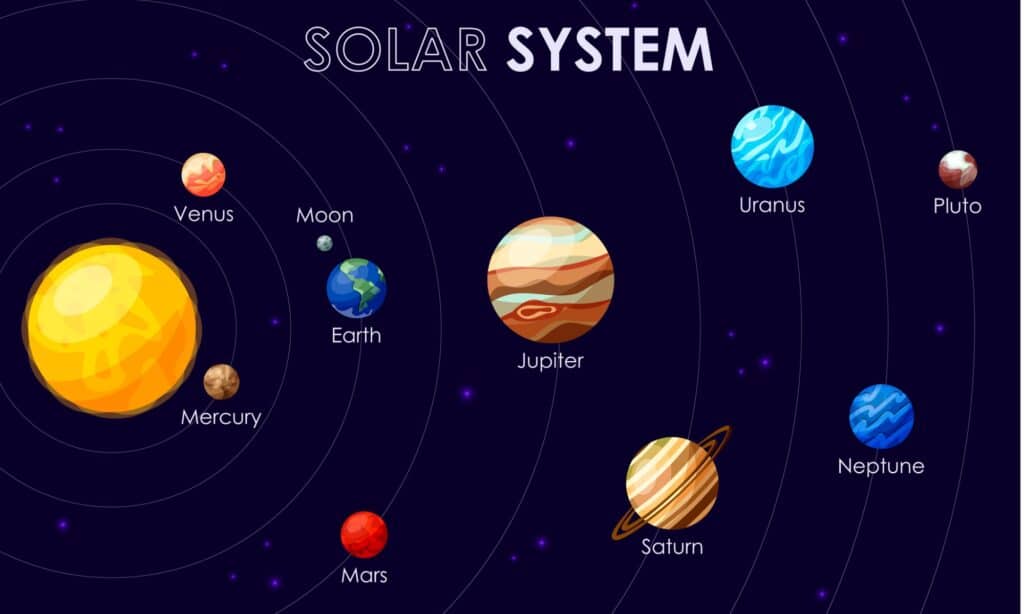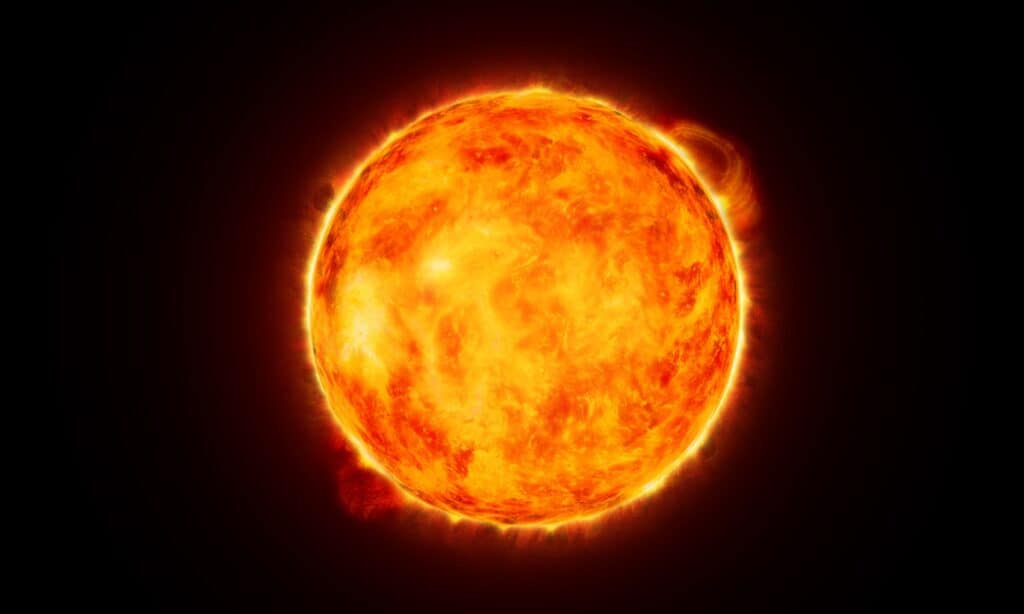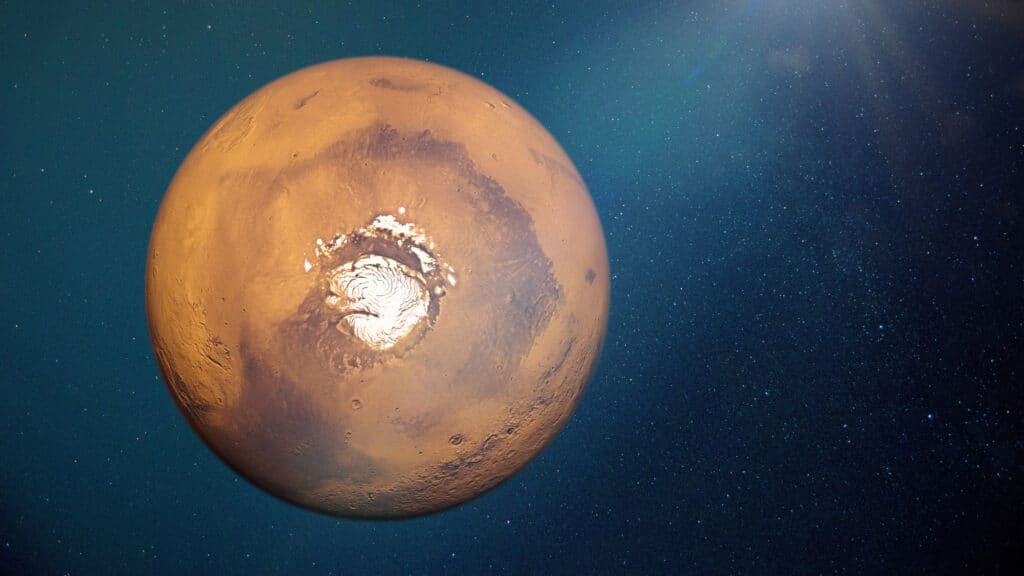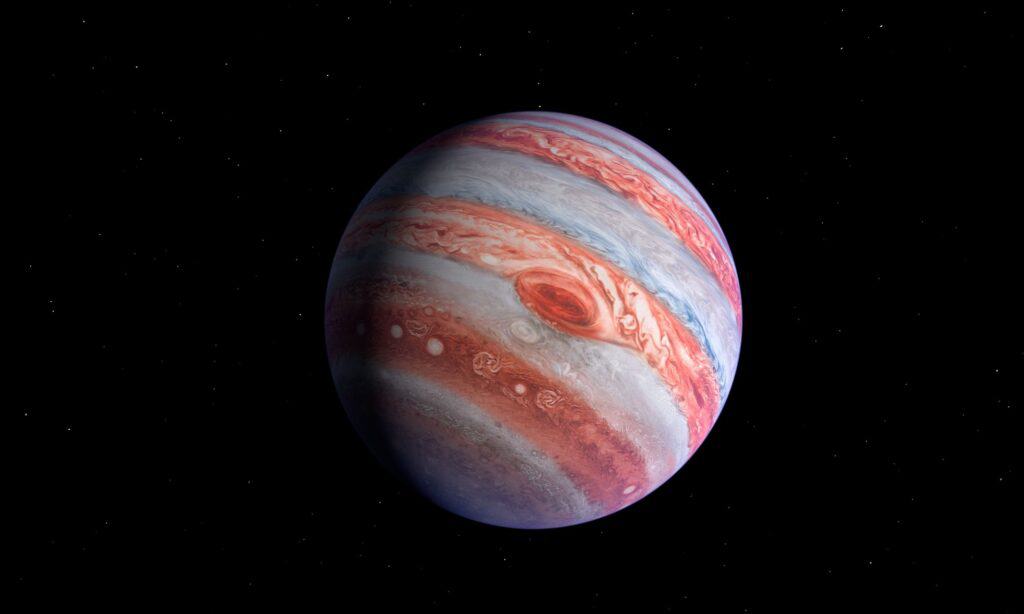Named after the Roman god of the sea, Neptune is a cold, twilit planet with an inhospitable reputation. Its signature cobalt blue color prompted its name, and it’s fitting – this planet doesn’t even have a solid surface! It lies further from Earth than any other planet in our solar system, further than the naked eye can see. Astronomers in 1846 found it using mathematical calculations, making it the first planet to be discovered in this way. So how far away is Neptune from everything else in our solar system? Read on to find out this and much more!
How Far Away Is Neptune?

Neptune is the 8th planet in our solar system, making it the furthest away from the Sun.
©iStock.com/Alexander Timoshin
Neptune is an average of 2.703 billion miles from Earth and 2.8 billion miles from the Sun. Its orbit is elliptical (egg-shaped), which means the distance between it and other celestial bodies is never static.
Besides miles and kilometers, there are other ways to measure distance. One way is by using astronomical units, or AUs. One AU is about 93 million miles, or the approximate distance between the Earth and the Sun. Another way is by using light years. A light year measures the distance light travels over the span of a single Earth year.
Distance From Neptune to the Sun: 2.8 billion miles

The average distance from Neptune to the Sun is 2.8 billion miles.
©iStock.com/hadzi3
The average distance from Neptune to the Sun is 2.8 billion miles or 30 AUs. Its aphelion (maximum distance from the Sun) is 2.82 billion miles, while its perihelion (minimum distance from the Sun) is 2.77 billion miles. Put another way, the planet is 0.000474600748 light years from the Sun.
The light from the Sun is about 900 times brighter on Earth than it is on Neptune. This is due to the vast distance between the two celestial bodies. As a consequence, the ice giant dwells perpetually in either twilight or night, seeing little sunlight.
Distance From Neptune to Earth: 2.703 billion miles

The average distance from Neptune to Earth is 2.703 billion miles.
©iStock.com/Thaweesak Saengngoen
The average distance from Neptune to Earth is 2.703 billion miles or 29.09 AUs. At their closest, these planets are 2.7 billion miles apart. At their farthest, 2.9 billion miles separate them. Neptune is around 4 times the size of Earth, which is about the difference between a baseball and a nickel. Up to 57 Earths could fit inside this planet! Its gravity is 1.14 times that of Earth.
Distance From Neptune to Mercury: 2.76 billion miles

The average distance from Neptune to Mercury is 2.76 billion miles.
©iStock.com/FlashMyPixel
The average distance from Neptune to Mercury is 2.76 billion miles or 29.70 AUs. No two planets in our solar system are further away than these. In contrast to Neptune, which takes an astonishing 165 years to revolve around the Sun, Mercury does so in just 88 days. It’s also the smallest planet in our solar system and has zero moons. Neptune has 14 moons, including its largest and most famous, Triton.
Distance From Neptune to Venus: 2.73 billion miles

The average distance from Neptune to Venus is 2.73 billion miles.
©iStock.com/buradaki
The average distance from Neptune to Venus is 2.73 billion miles or 29.37 AUs. Neptune has a reputation as the coldest planet in the solar system next to Uranus, with temperatures dropping as low as -373°F (-225°C). Venus, on the other hand, is the hottest planet in our system, with temperatures climbing as high as 872°F (467°C). It is also highly visible in our night sky, glowing a bright yellowish-white.
Distance From Neptune to Mars: 2.66 billion miles

The average distance from Neptune to Mars is 2.66 billion miles.
©iStock.com/dottedhippo
The average distance from Neptune to Mars is 2.66 billion miles or 28.56 AUs. Mars is most famous for being the most likely planet to host humans in the future. In this way, it differs significantly from Neptune. Several probes and rovers have taken measurements of Mars and have even landed on its surface, the most recent being NASA’s 2020 Perseverance Rover.
Distance From Neptune to Jupiter: 2.31 billion miles

Neptune is 2.31 billion miles from our solar system’s largest planet, Jupiter.
©joshimerbin/Shutterstock.com
The average distance from Neptune to Jupiter is 2.31 billion miles or 24.89 AUs. Jupiter is the largest planet in our solar system, easily dwarfing Neptune, which has the fourth-largest diameter and the third-largest mass of the 8 planets. Its so-called Great Dark Spot (a storm that has now dissipated) resembled Jupiter’s Great Red Spot, a massive persistent storm south of Jupiter’s equator.
Distance From Neptune to Saturn: 1.91 billion miles

The average distance from Neptune to Saturn is 1.91 billion miles.
©iStock.com/Elen11
The average distance from Neptune to Saturn is 1.91 billion miles or 20.57 AUs. Saturn has a set of 7 rings extending 175,000 miles from the planet; Neptune has 5 rings named after prominent astronomers who helped discover it. Saturn is the second-largest planet in the solar system next to Jupiter and the second of the 4 Jovian planets.
Distance From Neptune to Uranus: 1.01 billion miles

The average distance from Neptune to Uranus is 1.01 billion miles.
©iStock.com/IncrediVFX
The average distance from Neptune to Uranus is 1.01 billion miles or 10.88 AUs. These two planets are similar in many ways, including their diameter and mass. They also appear similar in color, though Uranus has a greenish tint. Methane in the atmosphere absorbs red light and causes these ice giants to appear blue.
How Long Does It Take to Travel to Neptune From Earth?
It takes about 12 years to travel to Neptune from Earth. In August 1977, the NASA spacecraft Voyager 2 launched into space. By August 1989, it reached the ice giant and was able to take photos and measurements. Given the difficulty inherent in traveling such a distance, it’s the only spacecraft to have made the journey.
Is Neptune Visible From Earth?
It’s impossible for the naked eye to see Neptune from Earth, even at its closest. The planet is simply too far away, even on a dark, clear night. As such, it’s the only planet in our solar system not visible without a visual aid. However, observers may be able to view it using binoculars or a telescope. This guide will help you catch a glimpse of this elusive celestial body.
Has Anyone Ever Set Foot On Neptune?

No human or spacecraft has ever landed on Neptune.
©iStock.com/3quarks
No human or spacecraft has ever landed on Neptune. This is partly because it doesn’t have a true surface. Instead, it has an atmosphere of hydrogen, methane, and helium extending down to a mixture of water, ammonia, and methane. The Earth-sized core is solid.
The other reason no one has set foot on this planet is the distance. Transporting a human would be prohibitive given the travel time and the resources necessary to make it happen.
Neptunian Climate and Lifeforms
Neptune is extremely cold and wet, without any landmasses or vegetation to support life. As such, there are no known organisms on this planet, not even plants. In addition to its brutal temperatures, it has the most powerful winds of any planet in the solar system. Wind gusts can reach up to 1,200 miles per hour (almost 2,000 kilometers per hour)! This puts even the windiest places on Earth to shame.
Without more powerful technology, we can’t hope to explore Neptune in person. However, you may be able to find this mysterious ice giant in the sky with the help of a telescope.
Check out this article on “How Much You’d Weigh On Neptune.”
The photo featured at the top of this post is © iStock.com/suman bhaumik
Thank you for reading! Have some feedback for us? Contact the AZ Animals editorial team.







